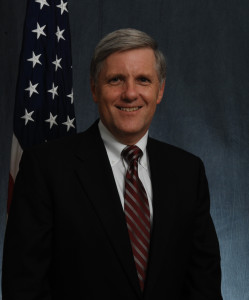Deputy Secretary of the Interior and Alumnus David J. Hayes to Visit Stanford Law School

STANFORD, Calif., April 30, 2013—In fall 2013, alumnus David J. Hayes, JD ‘78, who currently serves as the Deputy Secretary of the Department of the Interior, will be at Stanford Law School as a distinguished visitor from practice to teach a law and public policy seminar on the effects of energy and large infrastructure projects on land, water, and wildlife.
Throughout his career, David Hayes has been involved in developing creative solutions to environmental and natural resources challenges. As the second-in-command at the Department of the Interior, Hayes has served as the Department’s Chief Operating Officer (COO) and has had authority over all of the Department’s bureaus and agencies. In this role, he has promoted conservation initiatives, encouraged thoughtful renewable energy development on public lands, implemented unprecedented oil and gas safety reforms after the Deepwater Horizon disaster, worked to fulfill the nation’s trust responsibilities to American Indians and Alaska Natives, managed the nation’s water supplies sustainably (including improvements to California’s water infrastructure), and implemented the Department of the Interior’s scientific integrity policy. Prior to his government service, Hayes was a partner and global chair of the environment, land, and natural resources department at Latham & Watkins LLP.
At Stanford Law School Hayes will teach Energy Projects and their Environmental Impacts: A Seminar Exploring How Legal Tools Can Address Conflicts between these Societal Interests. The seminar will explore existing mechanisms that government officials use (or don’t use) to mitigate negative effects on resources. Students will develop—and present to government officials—their recommendations for new approaches that can more efficiently and effectively mitigate environmental impacts associated with infrastructure projects.
“We are delighted to welcome Deputy Secretary Hayes back to Stanford Law School,” said Dean Elizabeth Magill. “David has proven himself to be a visionary, effective, and wise policy maker. We are creating more opportunities for our students to work on complex public policy questions, and we look forward to supporting his course through the school’s new Policy Laboratory. David will be an ideal teacher. In addition, the entire community at Stanford will benefit from his presence.”
“I’m looking forward to teaching this course about how government can work with industry and stakeholders to balance the interests of environmental protection and natural resource conservation with the nation’s important energy needs,” said Hayes. “I know that Stanford students are world-class and so I’m ready to engage in a great dialogue on energy development and public policy.”
More on David Hayes
Before his appointment as Deputy Secretary, Hayes served as a leader in President Obama’s Transition Team, heading the agency review process for the Department of Energy, Department of Agriculture, Department of the Interior, and Environmental Protection Agency. In July 2011, President Obama appointed Hayes as Chair of the Interagency Working Group on Coordination of Domestic Energy Development and Permitting in Alaska, which works to organize the efforts of federal agencies that oversee the safe and responsible development of onshore and offshore, renewable and conventional energy in Alaska. This month, Hayes released a report to the President, Managing for the Future in a Rapidly Changing Arctic, recommending that the United States develop an innovative, government-wide “Integrated Arctic Management” strategy for the rapidly changing Arctic.
Additionally, Deputy Secretary Hayes co-chaired the Secretary’s Energy and Climate Change Task Force; he played an instrumental role in settling the long-standing Cobell Indian trust litigation and oversaw implementation of the settlement; he headed up the Interior Department’s response to the Deepwater Horizon oil spill for the secretary, managing day-to-day operational issues and overseeing the Interior Department team that responded to the disaster; and, in his COO role, he served on the President’s Management Council and was engaged in IT transformation and other management initiatives at the 70,000-employee department.
Hayes previously served as the Deputy Secretary and counselor to the Secretary of the Interior in the Clinton administration. He worked for many years in the private sector where he chaired the Environment, Land and Resources Department at Latham and Watkins, an international law firm. He is a former chairman of the board of the Environmental Law Institute; he was a consulting professor at Stanford University’s Woods Institute for the Environment; he served as a senior fellow for the World Wildlife Fund, and was the vice-chair of the board of American Rivers. Hayes has written and lectured widely in the environmental and natural resources field.
Hayes graduated summa cum laude from the University of Notre Dame and received his JD from Stanford Law School, where he was an editor of the Stanford Law Review. He is the former chairman of the Board of Visitors for Stanford Law School.
About Stanford Law School
Stanford Law School is one of the nation’s leading institutions for legal scholarship and education. Its alumni are among the most influential decision makers in law, politics, business, and high technology. Faculty members argue before the Supreme Court, testify before Congress, produce outstanding legal scholarship and empirical analysis, and contribute regularly to the nation’s press as legal and policy experts. Stanford Law School has established a new model for legal education that provides rigorous interdisciplinary training, hands-on experience, global perspective and focus on public service, spearheading a movement for change.
